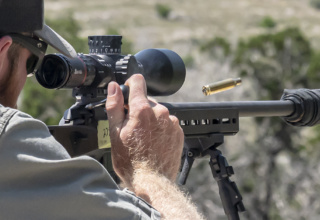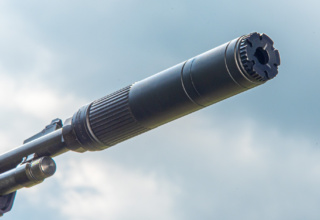“Long-distance” is a relative term in the hunting world, but whether 50 yards or 500 yards is stretching it out for you, here are some tips that will help extend your lethal zone.
Ask ten hunters what they consider to be a long-distance shot on a game animal and you’ll probably get as many different answers. The correct answer is measured not in distance, but in shooter skill and equipment. A long-distance, pushing-the-envelope shot for me is around 250 yards. When shooting in a hunting situation, that’s about as far as I can confidently make a kill shot. I simply cannot keep my rifle still enough to shoot any farther than that and know that the kill will be ethically quick. For other hunters, 300 yards may be their maximum ethical shooting distance, or perhaps 400 yards. Go much beyond that, unless you are shooting a highly specialized rifle and scope combination and have years of practice doping wind and calculating bullet drop, and most shooters are dancing in the “pull-and-pray” zone.
So, maximum shooting distances for ethically hunting game is relative to the skill and confidence level of the hunter. The thing is, it doesn’t matter whether you want to make clean shots at game animals that are 50 yards or 300 yards away, the principles of shooting accuracy are all the same. If you follow these shooting fundamentals, you’ll learn your maximum shooting distance, be confident that the shot you take will be true, and possibly push your personal “long-distance shot” a bit farther than you thought possible.
[quotes quotes_style=”bquotes” quotes_pos=”center”]”What we want to zero in on are a few facets of shooting basics that many hunters tend to forget…especially when they are in the field.”[/quotes]
Equipment Basics
Is one rifle setup better than another? No question about it. That said, we all are going to shoot what we like and the best we can afford…be that a particular brand, model, chamber, cartridge, optic, or accessory. The important thing is that your equipment fit your body and shooting style, that everything is properly set up, and that you find the load that shoots best from your particular barrel and stick with it.
A common problem many hunters have that can adversely affect accuracy is not having a comfortable fit when they shoulder their rifle. The length of pull may be too long or too short, which can force you to shoot in an unnatural position, or the scope may be mounted too far forward or backward to achieve proper eye relief, which can also cause you to shoot in an unnatural position. Remember when you were a kid and wanted a particular pair of sneakers but the store didn’t have the right size? You convinced yourself and your parents that the ill-fitting shoes would be fine because, darn it, you wanted those shoes! Later, of course, you paid the price. Don’t be that kid again! If your rifle needs to be adjusted, there are aftermarket solution, such as installing a longer butt pad or getting a gunsmith to trim some stock length. The point is to make sure your rifle fits and the scope is properly set up, because failing to do so will only frustrate your efforts to maximize your shooting distance.
Speaking of scopes, there are so many on the market today that picking the right one can be an exercise in frustration. I’ve seen people drop a month’s worth of wages on a high-power, multi-function, BDC reticle scope designed for 600-yard-plus shots knowing full well that it will never be used for more than dropping a whitetail at 100 yards max. I’ve also seen people try to use their 3X fixed scope for western hunting and expect to drop a mule deer at 300 yards. Not that it couldn’t be done, but it couldn’t be done by these hunters. The point is, you need a scope that fits your likely hunting conditions.
If your primary tactic is hunting whitetail in woods and fields where 50- to 100-yard shots are the norm, a scope such as TRUGLO’s new TRU•BRITE™ 30 Hunter is ideal. With a 1-4X magnification, wide-view 24mm objective, and fully coated lenses for optimal light transmission, this scope works great for rapid target acquisition in tight quarters, yet will easily deliver the kill shot out to the average maximum 200-yard range of most hunters.
For those whose long-range endeavors including dropping western game at ranges up to and beyond 300 yards, a scope such as the TRU•BRITE™ Extreme IR Rifle scope is a good candidate. This scope offers several features favored by those who have developed the skill and confidence to make those outside shots, including illuminated Dual•Color Bullet Drop Compensating or standard duplex reticles in red, green, and black, large 44mm or 50mm objective lenses for a wide field-of-view and brightness in low-light conditions, and magnification options covering 3-9X, 3-12X, and 4-16X.
Shooting Basics
Okay, we’re not actually going to cover all of the shooting basics here because most of you already have those well in hand. What we want to zero in on are a few facets of shooting basics that many hunters tend to forget…especially when they are in the field.
First is trigger pull. Precise, consistent shooting accuracy demands precise and consistent trigger pull. There are two techniques to keep in mind when pulling the trigger. One is to position your body, grip, and trigger finger so that you are pulling straight back with the pad of your index finger. This is another example of where proper gun fit comes in. If you aren’t pulling the trigger straight back with the end of your index finger, it means you are pulling the trigger to the side and running the risk of pulling it all out of alignment as the shot breaks. This condition is particularly noticeable when shooting a pistol, but it also has a detrimental effect when shooting rifles as well. Always pull straight back on the trigger in a slow, steady pull. The second technique is to follow through the trigger pull after the shot breaks. Simply put, keep pulling straight back on the trigger after the shot goes off. If you immediately let up on the trigger after the break (for example, to cycle the bolt for a follow-up shot), you risk disturbing the rifle alignment before the bullet leaves the barrel. Following up on the shot also keeps you in place to better see what is happening downrange. Did you hit or miss? Did the animal drop or is it running for cover? Stay calm, follow up the trigger pull, and observe.
Staying calm is also a key part of long-distance shooting accuracy during the shot cycle—particularly breathing control. In order to maintain a steady target lock and execute a well-placed shot when high magnification and adrenaline wreak havoc on platform stability, timing the shot with your breathing cycle is critical. Your body and sight alignment is most stable at the bottom of your breathing cycle (exhale). When you’re ready to make the shot, the goal is to lengthen the bottom of your breathing cycle (not hold your breath!) and break the shot midway through that extension. Focusing on your breathing cycle will help you calm down when things get tense.
Practice Basics
Now that you have your equipment and shooting fundamentals in check, it’s time to put them to practice.
It’s an old saw that bears repeating, but bench performance doesn’t necessarily translate to performance in the field. You may be able to stay in the ten ring at 200 yards from the bench, but it’s tough to do that when you’re stretched across a boulder or leaning your rifle against a tree. Fortunately, practicing under realistic field conditions (or as close to them as you can get) will serve you well when that trophy is standing on the ragged edge of your comfort zone.
Once you have your rifle zeroed, you should spend your practice sessions shooting from various positions away from the bench. Bring your hunting pack to the range, throw it on the ground and practice shooting prone at various distances. Do the same while sitting, shooting freehand, shooting with sling support, and shooting while propped against a vertical support. You may be surprised that your effective maximum shooting distance changes significantly with each shooting position. The same is true if you use shooting sticks or a monopod. Until you actually practice with these supports, you’ll never know your limits or be able to improve your accuracy at longer distances.
A side benefit of practicing for long-distance shots is the improved accuracy you’ll gain when shooting at closer distances. If you are also a bowhunter, you know that when you practice regularly at 50 or 60 yards, those 20- to 30-yard shots are as easy as buttering bread. The same is true when shooting a rifle. The difference is that you must be cognizant of changes in bullet trajectory and parallax changes due to scope magnification. That is one of the advantages of having a scope with a BDC reticle, which is available with TRUGLO’s TRU•BRITE™ Extreme IR rifle scope. You can calibrate the scope to most centerfire cartridges on the market today, giving you precise and confident shot placement out to 600 yards.

And Finally…
Make life easier on yourself and maximize your range time by using high-visibility targets such as the TRU•SEE Splatter targets by TRUGLO. Their bright green impact rings allow you to see your point-of-impact at long distances much better than conventional paper targets. Using TRU•SEE™ Splatter targets will significantly reduce your zeroing time, and keep you from having to wait for the “all clear” every time you need to check your target.

As you can see, a lot goes into extending your effective (ethically lethal) shooting distance. Refine your setup to suit your needs, then practice the basics both on the bench and off. Then, whether that trophy is 20 yards or 200 yards away, you can shoulder your rifle with confidence.













